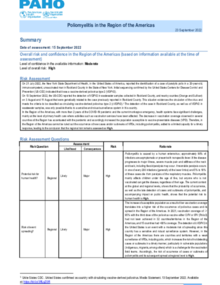Poliomyelitis in the Region of the Americas - Risk assessment

|
On 21 July 2022, the New York State Department of Health, in the United States of America, reported the identification of a case of paralytic polio in a 20-year-old, immunocompetent, unvaccinated man in Rockland County in the State of New York. Initial sequencing confirmed by the United States Centers for Disease Control and Prevention (US-CDC) indicated that it was a vaccine-derived poliovirus type 2 (VDPV2). On 13 September 2022, the US-CDC reported the detection of VDPV2 in wastewater samples collected in Rockland County, and nearby counties (Orange and Sullivan) on 3 August and 11 August that were genetically related to the case previously reported in Rockland County. This situation evidences the circulation of the virus and meets the criteria to be classified as circulating vaccine-derived poliovirus type 2 (cVDPV2).1 The detection of the case in Rockland County, as well as of VDPV2 in wastewater samples, was only possible thanks to a sensitive and robust surveillance system in this country. In the Region of the Americas, with more than 2 years of the COVID-19 pandemic and the current monkeypox emergency, health systems face significant challenges, mainly at the level of primary health care where activities such as vaccination services have been affected. The decrease in vaccination coverage observed in several countries of the Region has accentuated with the pandemic and accordingly increased the population susceptible to vaccine-preventable diseases (VPD). Therefore, in the Region of the Americas cannot be ruled out the occurrence of new cases and/or outbreaks of VPDs, including poliomyelitis, added to a limited capacity for a timely response, leading to the conclusion that the regional risk remains assessed as High. |
